|
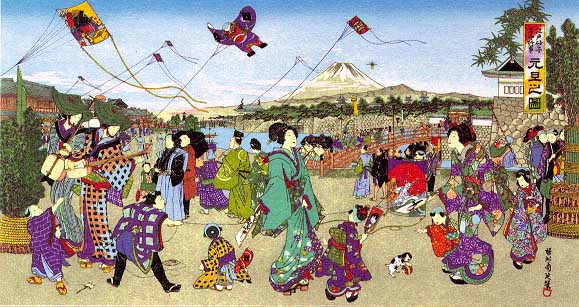
Japan's kites are among the most spectacular in the world, treasured as much for
the aesthetic worth as for the pleasure they give as toys. The traditional kite
consists of a light bamboo or wood frame over which is affixed paper painted
with various bold motifs, ranging from faces of legendary war heroes to
brilliant geometric patterns; in the hands of a skilled craftsman, the Japanese
kite becomes a work of art.
Japanese kites are made in immense ones of over a thousand square feet, and in
many different shapes. Many of them require considerable skill in handling if
they are to be airborne successfully. Japanese kites possess a history of
association with folk religion and figure in a number of famous military
adventures. Today's kites are source of pleasure for this reason as well, for
they draw upon, and to some extent preserve, traditional legend.
Variety shapes of Japanese Traditional Kites are offered here after. The giant
kites such as Shirone, Hamamatu, Sagamihara, Showa-machi(Hojubana), Ikazaki,
Yokaichi and Wan Wan
Kites hereinafter except Tsugaru kite have a single line and are made from
bamboo and Washi (Japanese paper). The material of the frame of Tsugaru kite is
made from white ceder(Hiba).

AIZU-TOJIN
This kite has a peculier shape comparing with other kites which were born in
Fukushima prefecture, Northern part of Honshu island. It is believed that the
origin of this kite came from Goto,Iki,Nagasaki where is located in southern
part of Japan. After painting, the sail paper is painted with tan for
strengthening its sail. This method is very peculier in Japan. The design of
this kite means "Judge of Hell," the Devil in the heaven.
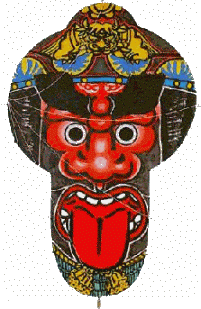

ASHINAGAYAKKO
This kite is a kind of Yakko and it has long legs which act as a stabilizer or
tail for balance. "Ashi" means 'legs' , "Naga" means 'long'
and "Yakko" means 'a servant' in ancient era. Many kinds of Yakko-dako
are produced in in Shizuoka prefecture and among them, Ashinaga-Yakko is most
outstanding Yakko.
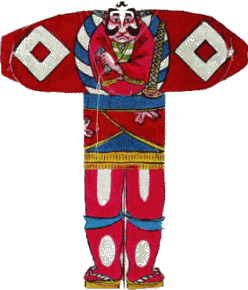

BARAMON
This kite is said to be transferred from east Asia, such as India, Malaysia and
Indonesia. The shape of this kite is very unique and not so popular in Japan.
This type of kite is made at Hirado, Iki and Goto islands in Nagasaki prefecture
located in southern part of Japan.This kite has an hummer on it. The design of
the kite is that Damon bites the helmet of old soldier, Samurai.
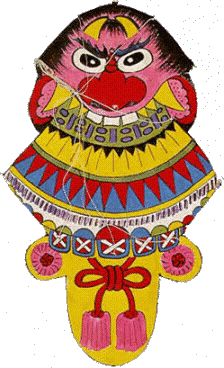

BEKKAKOU
BEKKAKOU has a humorous look and needs a tail to get a stable flight. This type
of kite is originated in Yokosuka district, Shizuoka prefecture which is famous
for having a variety of kites. The eyes of this kite is painted with silver
color and has a rotating mechanism with the wind.
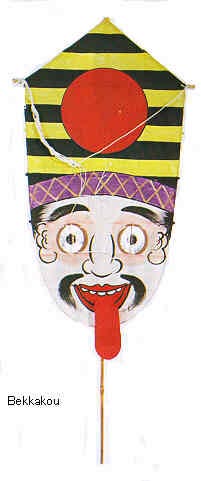

BUKA
BUKA is one of the fighting kites and the fighting technique of BUKA needs skill
and experience. It has two bridles and has no tail. The birthplace of Buka is
Shizuoka Prefecture. There are so many kinds of kites in Shizuoka, Japan.
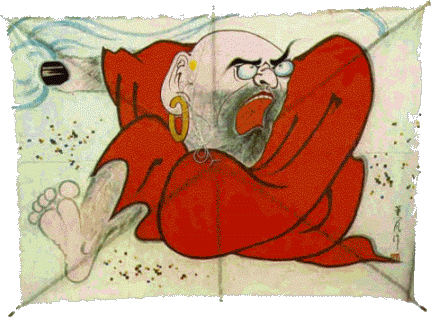

BUTTERFLY
BUTTERFLY kite is not so popular in Japan. There are many variation of this kind
of kites and this is a typical one. There are another "Bee-kite",
"Dragonfly-kite", "Cicada-kite", "Horsefly-kite, "Kite-kite",
"Owl-kite" , "Crow-kite" , etc.


CHOCHIN
Chochin is Japanese lantern and this kite resembles chochin.
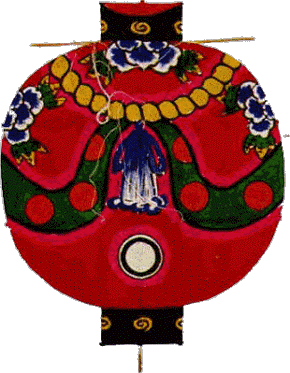

DARUMA
DARUMA means Bodidharma, ancient great Buddhist. He prayed during nine years on
the stone table without moving. His legs and arms has vanished. You can see
variety of painting of Bodhidharma at a shrine or a temple in Japan. A long
single tail is needed to fly this kite. The birth of this kite is Hatano city,
Kanagawa prefecture.
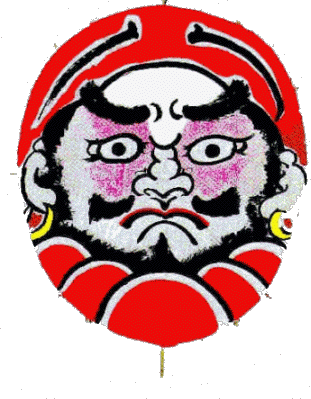

EDO
'Edo' is the old name of Tokyo and this kite is one of the most decorative kite
today in Japan. Its painting designed was depicted for famous historical stories
or traditional stories in Japan.
Today, Edo-dako is designed so as to be assembled at the flying site because of
convenience for handling. The number of bridles of Edo dako are 11 or 14 and
each length of strings is about 20-25 times of its height. It is very difficult
to adjust the center position of strings for good flight. It is famous for its
large hummer on the top of kite. This kite is fit for the wind speed of 5
m/second - 15m/second. The works of Teizo
Hashimoto are shown. A hummer is fixed on the top of kite and sounds with
wind.

EDO KAKU
Edo kaku is a smaller size of Edo such as 30-60cm in width and 60-90cm in height.
This kite is very popular as well as Yakko-dako in Japan. It has three bridles
and usually two tails.
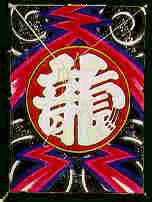 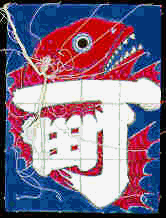 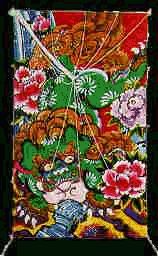 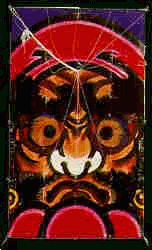 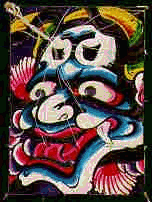

ETO DAKO
Eto means the twelve horary signs in Japan. Each year has own symbol of Eto, and
it appears every twelve years. It is called as Ne(Mouse), Ushi(Ox), Tora(Tiger),
U(Rabbit), Tatsu(Dragon), Mi(Snake), Uma(Horse), Hitsuji(Ram), Saru(Monkey),
Tori(Bird), Inu(Dog),I(Boar) in order. 2001 is the year of Mi(snake). Those
kites were built by late Teizo Hashimoto as memorial kites for each year.
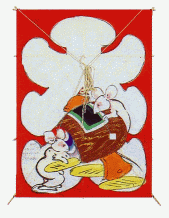 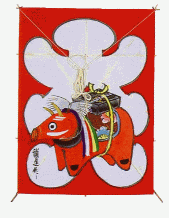 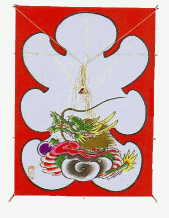 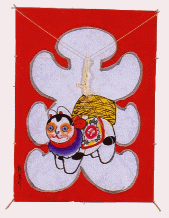

EZO DAKO
Ezo means Hokkaido district which is located northern part of Japan. This kite
was designed in 1968 by Mr.Hikoso Ohta who lived in Hakodate, Hokkaido where was
called "Ezo" formerly.
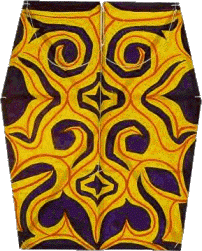

FUGU
FUGU means a globefish which has globefish poison. The face of this kite
resembles a globefish and has a humorous look. It is very difficult to fly
without tails. This kite was originated in 1961 in Shimonoseki, Yamaguchi
prefecture. Shimonoseki is very famous for production of globefish. It has an
hole for wind in the center of kite which resembles with a Korean kite.
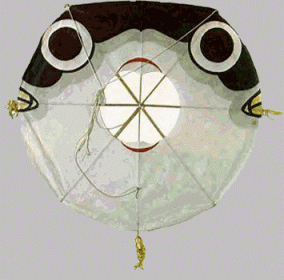

FUKUSHIMA DAKO
This kite is delivered to neighboring people for praying getting rid of evil and
unhappiness of a man or woman whose age is 42 years ord ofr man or 35 years old
for woman.
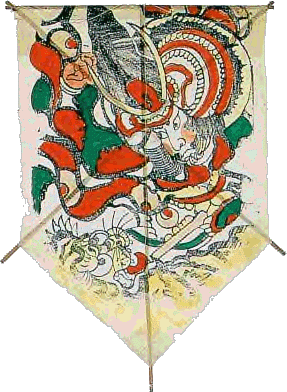

FUKUSUKE
FUKUSUKE is beleived as a symbol who brings happiness and prosperity to people.
He is sitting with wearing Kamishimo (old stype Japanese formal dress).
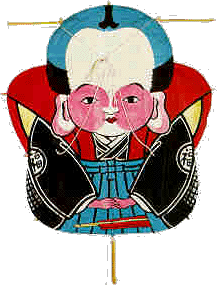

GORYOUKAKU
Goryoukaku means the old historical memorial of castle which locates at
Hakodate. This kite was originated by Mr.Hikozo Ohta.


HACHI
HACHI means a bee and I think that the shape of this kite came from eastern Asia
like as Malaysia, or Indonesia.


HAKODATE IKANOBORI
This kite was originated by Mr.Hikozo Ohta.


HATA
Hata is build at Nagasaki Prefecture, Kyushu. It does not look like other
Japanese traditional kite in shape. It is beleived that this kite is imported
from fareast Asian counties,such as China,Thailand and Indonesia.
Nagasaki was the only one harbour when Japan closed to foreign contries during
Edo period(1603-1867).
It is fairly certain that Nagasaki Hata fighting kite is a derivation of the
Indian Fighter. It bears a close resemblance to the classic Indian Fighter,
differing only in the absence of the Indian support fin at the tail, and in
having its two leading edges supported by guidline of string, while the Indian
version has its leading edges unsupported. Nagasaki Hata is traditionally
coloured red, white and blue, in the manner of the Dutch ensign.
This is an exceptionally manoeuvable kite capable of flying at amazing speeds
with consideerable directional control. Equipped with cutting devices such as
porcelain glued to the line below the bridle be means of egg white, rice or
other natural adhesives, it is a fearsome opponent in competition.
Please refer toMaking Process of HATA which
is shown with 20 photos.
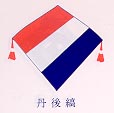  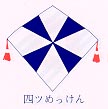

HIBUSE
This kite is made in memory of fire prevention and a kind of Yakko-dako. This
type of kite has sleeves to catch wind. Sleeves have function to stabilize its
flying feature. It is better to have tails to get more stability.
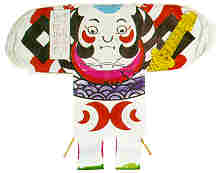

HINODETSURU
'HINODE' means sunrise and tsuru means a crane.Tsuru is one of the symbol of
auspicious event and long life.
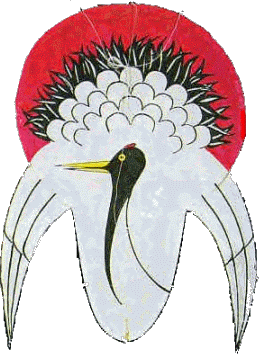

HITODAKO
Hitodako was born in Akita prefecture.It has a large figure of man on the face
of the kite.
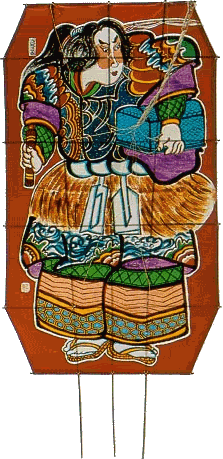

INMYOJI DAKO
Inmyojidako was generated at the beginning of Meiji era, about 130 years ago. It
is the special feature that this kite has no slant frame .
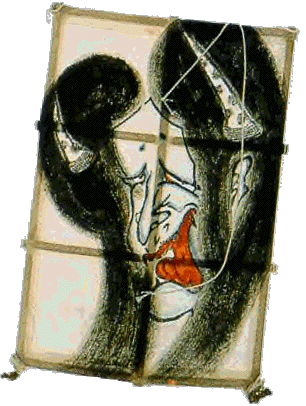

ITSUWA
'Itsuwa' means five rings. This is a simbol of happiness and prosperity. This
kite is strongly influenced by Chinese kite and is made in Kagawa prefecture of
Shikoku island.
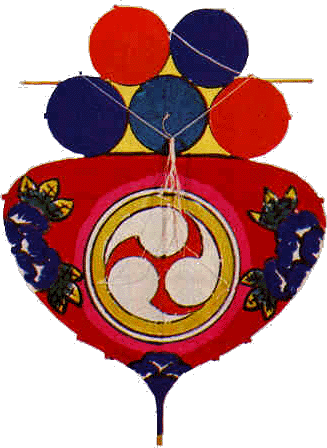

IWAIDAKO
Iwaidako is the celebrating kite. Japanese character (Kanji), "crane"
which means the symbol of a long life is drawn on the kite.
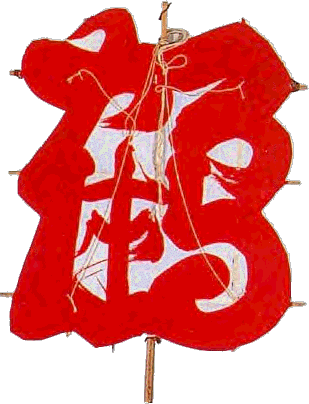

JIDAKO
'JI' means the character and JIDAKO means the kite which is painted with
Japanese character usually and the character of this kite shows
"dragon" in Japanese character. In Japan many kinds of kites are
painted with Japanese characters which means happiness and the name of child.
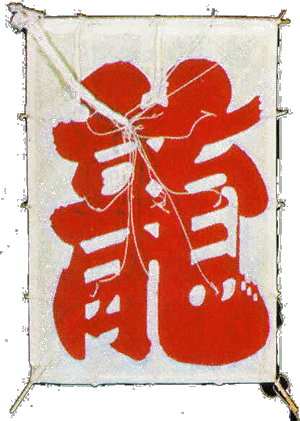

KAMEDAKO
Kame means a turtle. It is a special feature of this kite that the corner of the
kite is cut away.
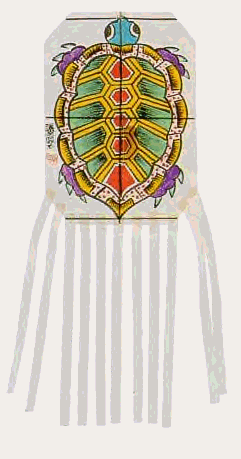

KARAKASA
'Karakasa' means Japanese umbrella which is made by bamboo and Japanese paper
painted with oil.
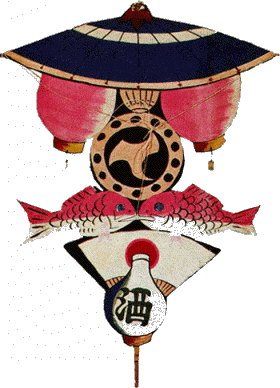

KARA-KINTOKI
This kite was born in Nagasaki, Kyushu. 'Kintoki' means a hero who appears in
Japanese old tale.
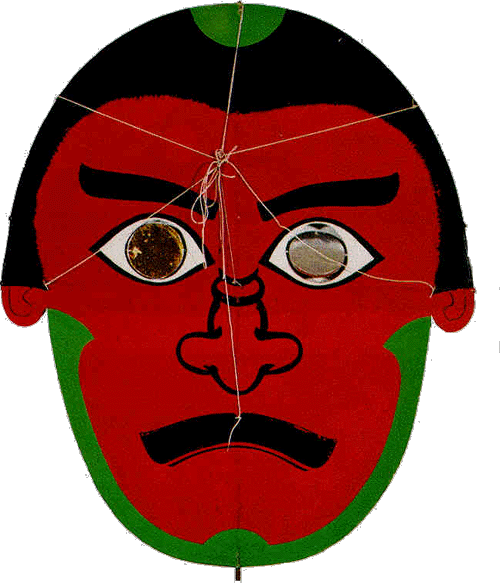

KERORI
KERORI has very curious shape and it is rather difficult to keep its flight
stability without tails.
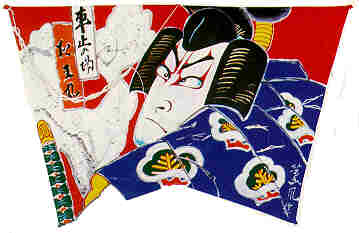

KINTOKI
'Kintoki' means a hero who appears in Japanese old tale.
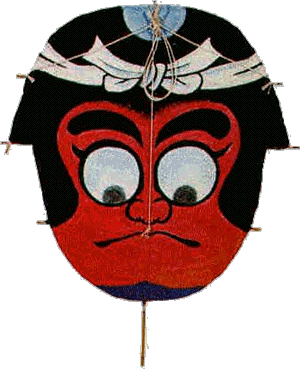

KOMA
'KOMA' means a top. The shape of this kite is between Rokkaku and Kaku dako. Its
flight feature is excellent and does not need any tail to fly.
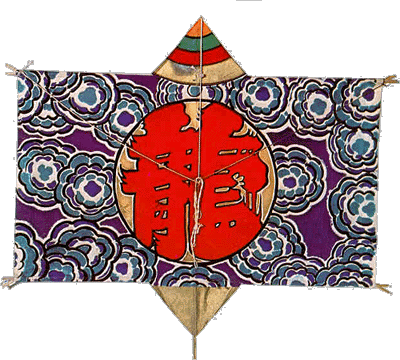

KORYU-SEMI
KORYU-SEMI has a very excellent feature to fly stable at strong wind speed at
8-15m/sec. It is very difficult to build KORYU SEMI because it needs a special
sooty bamboo for its frame, Washi(Japanese paper) and excellent technique and
experience to build. KORYU means old style and SEMI means a cicada.
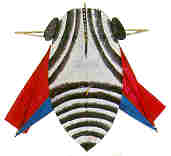

MACHIJIRUSHI
Machi means town and Jirushi means symbol. This kite is a kind of symbol of a
town. Kite fighting festival in Hamamatsu is held among towns on May evry year.
Those 168 towns have their own kite to fight.
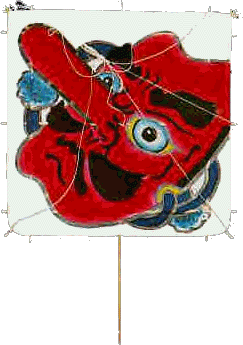

MATTAKU
This kite was born in Okinawa, southern island, Japan. The shape and painting of
this kite is geometrical pattern which we cannot find anywhere in Japan.
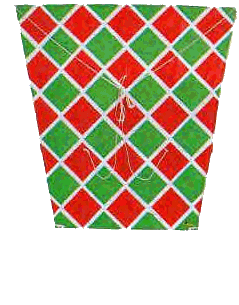

MANAGU
Managu means eyes.This kite is painted only Sumi, Japan ink. The flight feature
is very excellent.
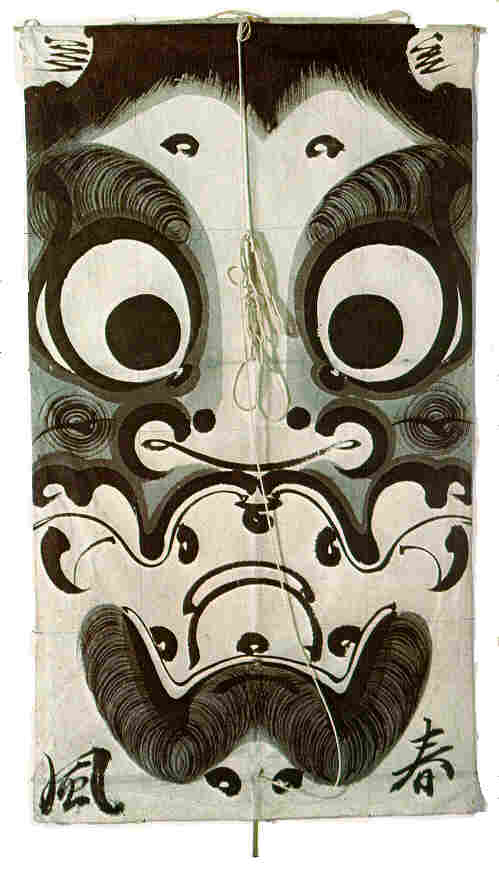

NOSHIRO DAKO
Noshirodako has a feature having two vertical frame and four horizontal frame.
It has no frame at the bottom of the kite.
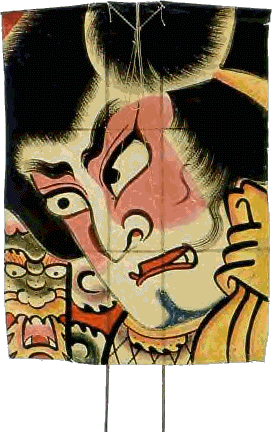

OHGI
Ohgi means a folding fan. It is unbelievable that Ohgi kite can fly in the sky.
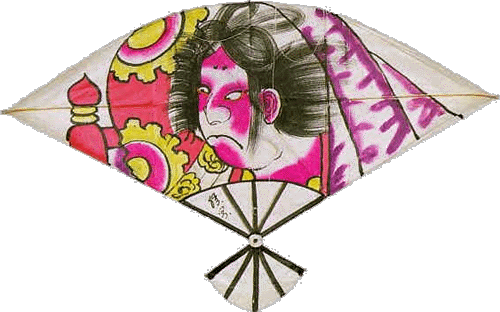

OHJI
'OHJI' ia a kind of Yakko dako. It needs tails to fly stable.
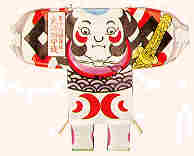

OKI
'Oki' is a name of island where this kite was born.
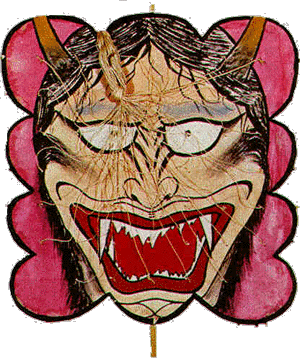

ONIDAKO


ONIYOCHO
This kite has very strange shape comparing with other Japanese kites. This kite
is made in Hirado, Nagasaki prefecture.
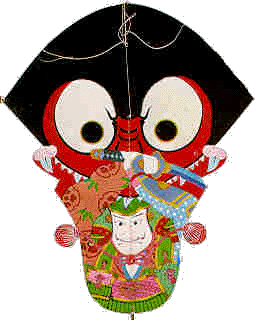

ONIYOUZU
'ONI' means a demon and 'YOUZU' means a kite. This kite is a kind of an exorcism.
Praying for family's happiness and healty life, people fly this kite at New Year
festival.
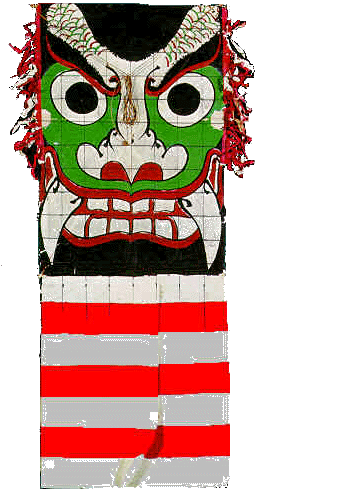

ONNABERABO & OTOKOBERABO
This kind of kite is called Noshiro dako. This kite has two vertical spars and
three horizontal spars. The construction of the kite is very peculier shape. 'ONNA'
means woman and 'BERABO' means ridiculous. It has a humolous painting. There is
another OTOKOBERABO, and 'OTOKO' means a man.
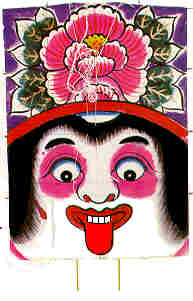 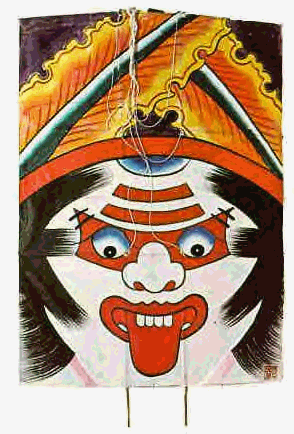

ROKKAKU(SANJO)
Rokkaku means hexagon, and is famous for its excellent flight feature, stability
and simplicity of the construction among Japanese kites. This kite was bone in
Sanjo, Niigata prefecture, northern center of Japan and is also called as
Sanjo-Rokkaku. Today, this type of kites made by variety of materials are seen
around the world.
Any size can be built and its flight feature is very stable at any wind speed.
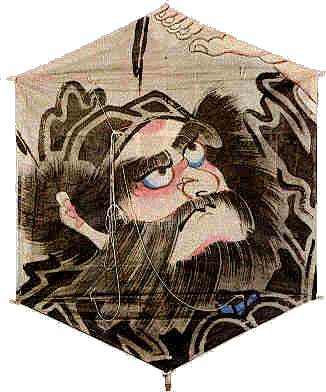 

ROKUGOU TONBI
'ROKUGOU' ia the name of place near Tamagawa river, Tokyo and 'TONBI' means a
kite of bird. Tonbi is a kind of pronoun of kite in Japan. It flies just like a
bird without tail at middle wind speed (3 to 7m/sec).
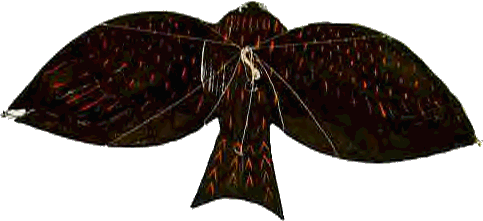

SAGARA
'SAGARA' means the district of Shizuoka prefecture, and this kite was born
there.Typical twenty kites are shown on the page of SAGARA. Sagara kite was born
in the early eighteen century.This kite has two bridles and no tail and a kind
of fighting kite.
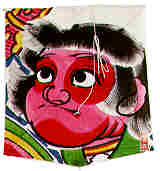

SAKATA YAKKO


SAKAZUKI DAKO
'SAKAZUKI' means wine cup. This kite exhibits a very stable flight even if the
shape is peculiar.
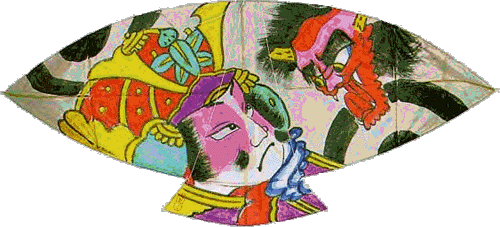

SEMI
'SEMI' means a cicada in Japanese.
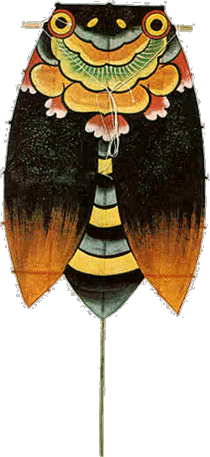

SHOGI
'SHOGI' is a kind of Japanese game like a chess and this shape resembles with a
piece of Shogi, like as King of chess. This kite is born in Chigasaki city,
Kanagawa prefecture neaby Tokyo. It needs a long tail made by rope and needs
strong wind to fly. It has a small hummer on top of the kite.
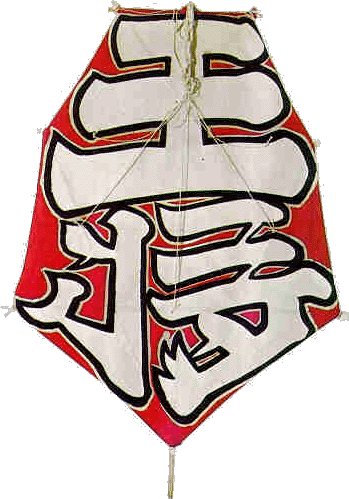

SODE
The shape of Sode-dako resembles Japanese kimono. Sode means sleeves of Japanese
Kimono. This kite has a large hummer on the top of kite. It needs the strong
wind to fly this kite stable. This kite is build and fly to pray new born boy's
future happiness and their health.
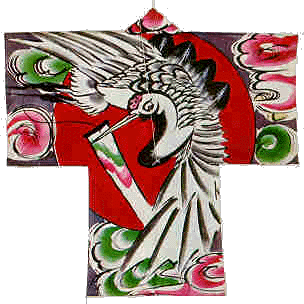

SURUGA
SURUGA-dako has the special features that the both side of the kite has a
branchia. This kite can be build from square paper sheet without any idle by
cutting. This kite is made in Shizuoka prefecture.
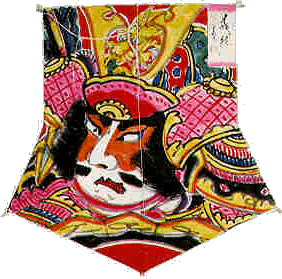

SURUMETENBATA
This kite is made at Sendai, Miyagi prefecture. The shape of the kite resembles
dried a cattlefish which is the famous product in this district.
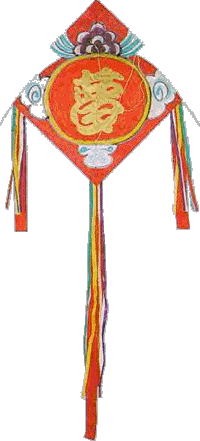

TAMETOMO
'TAMETOMO' is a famous warlord who lived in the end of Heian era (794 - 1180).
He was sent to Hachijo island for his crime and this kite is said to be the
memory of his name.
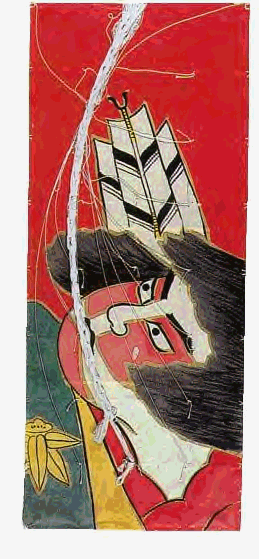

TOMOE
The design of this kite is separrated into three parts. The cirkle part of the
top of kite means the crest of the owner of Yokosuka castle. The two diamond
shaped lozenge shape located at center part of the kite means the family crest
of Takeda who is the famous warrior. The folding fan located at the bottom of
the kite means means the simbol of Tokugawa shogun.The design of this kite tells
about the war on which those three famous Samurais fought.
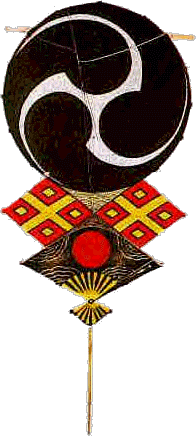

TONBI
'TONBI' means a kite.
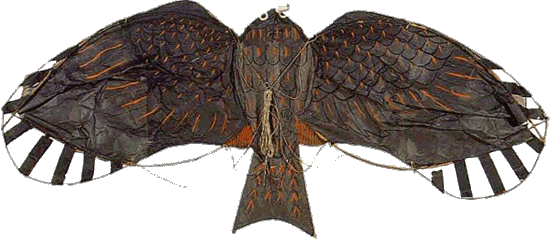

TONGARI & ATAMAKIRE
'TONGAI' and 'ATAMAKIRE' are relatives for its shape and birth. These kites are
for wishing good fortune and health of family. The simbol of happiness such as
crain, turtle, pine, bamboo, plum tree and top shell is drawn on the kite. The
red color which is the simbol of happiness occupies more than half of the face
of kite. This kite is flew at the event of the celebration.

TOSA
The square-sailed TOSA dako is similar to Franklin kite, Delta or HATA. It might
be the delta's true ancestor. It is popular that the painting on the kite is the
crest of the family. The kite takes its name from the vast bay of Tosa on the
south side of Shikoku island, within the Kochi prefecture.
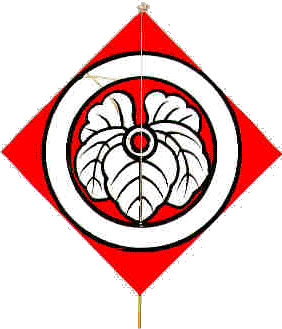

TSUBAME
'TSUBAME'means a swallow.
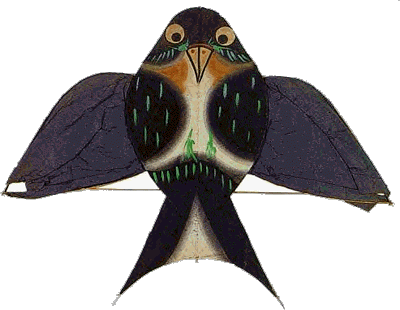

TSUGARU
The kite takes its name from Tsugaru district, northern part of Aomori
prefecture which is the birth place of the kite. This kite is different from
other Japanese kites. It has wooden frame instead of bamboo which is usually
used by other kites. The painting of Tsugaru is one of the most decorative and
impressive kite in Japan.
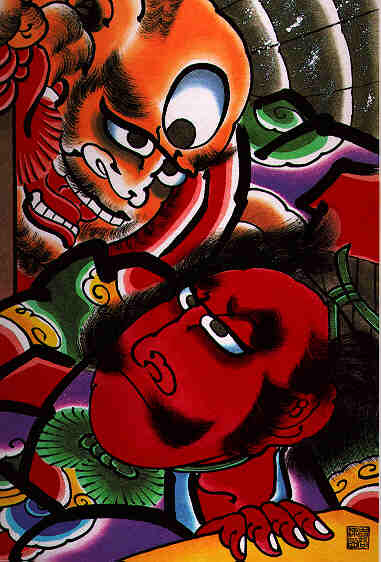

YAKKO
YAKKO-dako is one of the most popular kite in Japan. It is very difficult to fly
without tails, so children attach 2-4m length of tails made by cut newspaper or
other tape.
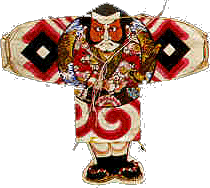

YOSHITSUNE
Yoshitsune Minamoto is a famous soldier who lived between the end of Heian era
and the beginning of Kamakura era. (1159-1189)
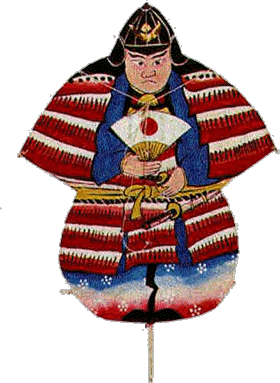

| 